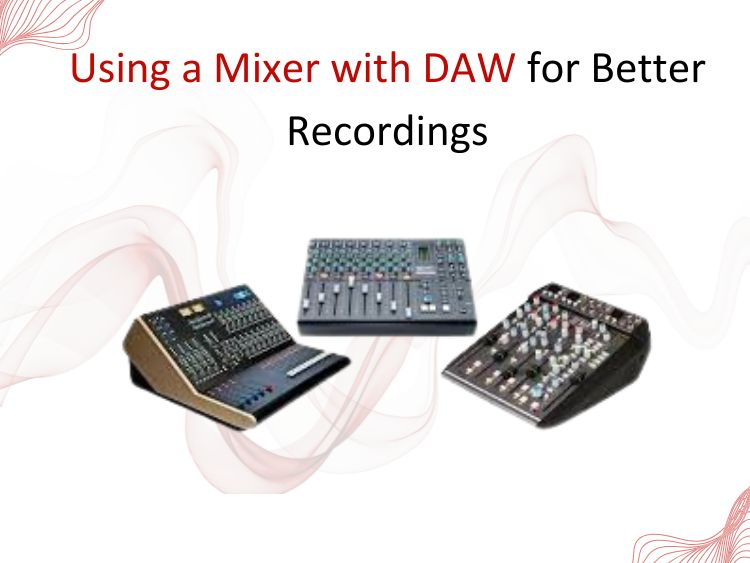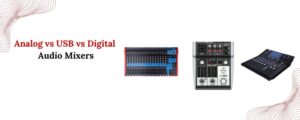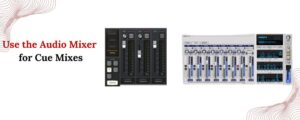Modern producers usually work within a digital audio workstation (DAW), as they find everything they need for mixing, recording, and editing within the software. However, using a hardware mixer in conjunction with your DAW can significantly improve your recording experience both in terms of quality and control.
For the best collection of audio mixers, explore 5 Core Audio Mixer collections that suit your budget.
From seamlessly capturing the performance of a full band, to crafting intricate electronic music or even podcasting, the combination of a DAW and a mixer can give you the best of both analog and digital worlds. This blog describes the steps to use a mixer with your DAW for top performances.
Steps to Use a Mixer with Your DAW
Step 1: Choose an appropriate mixer
Not all mixers are created equal. Choices must be made based on recording needs.
- Analog Mixer: Best sound regarding warmth and color will require a good quality audio interface to route signals to your DAW.
- USB/FireWire Mixer: These mixers are class-compliant, which means they often work as audio interfaces, so several channels can be sent directly to the DAW.
- Digital Mixer: Usually comes at a higher cost, giving more freedom with how the signals are sent out and the routing they have in the mixer itself, along with preloaded effects.
For home studios, a USB mixer like the Behringer Xenyx Q802USB or Mackie ProFX10v3 offers great features without sacrificing affordability.
Step 2: Correctly Integrate Your Mixer with the DAW
Observe that composition include:
Audio Interface Method (with Analog Mixer):
- Link the main output (or direct outs) of the mixer to the line inputs of the audio interface.
- Feed audio from the interface to the DAW via USB.
- DAW playback can be returned to the stereo input of the mixer or a dedicated return.
USB Mixer Method:
- Link the mixer through USB to the computer.
- Choose the mixer as the input/output in the DAW’s audio settings.
As a rule, always set sample rates and buffer sizes as needed to avoid latency.
Looking to buy a 24 channel DJ Audio mixer? Check the 5 Core Audio Mixer 24 Channel DJ Mixing Board Bluetooth USB Analog machine at easy costs.
Step 3: Optimizing Gain Control From A Signal Flow Standpoint
Optimizing gain staging is an essential underlying principle for achieving clean recordings:
- Set the trim/gain knob on the mixer so your input peaks at -6dB on the level meter; this is when you set the input on the mixer’s level meter.
- Do not add any distortion or clipping, especially when recording vocals or acoustic instruments.
- If your mixer offers the option, use pre-fader direct outs for added flexibility with mixing later, sending dry, unprocessed signals to your DAW.
Step 4: Use the Mixer for Cue Mixes
One of the best advantages of using a mixer is zero-latency monitoring.
- Setup aux or headphone buses on your mixer.
- Send custom monitor mixes to musicians, separate from what’s being recorded.
- This is especially helpful when tracking bands or vocalists who need different headphone mixes.
Step 5: Record with Hardware EQs and Effects (Optional)
Many mixers come with built-in EQs or even onboard effects. You can:
- Use light EQ shaping on vocals or drums before they hit your DAW.
- Add reverb or delay for monitoring only (don’t print them to track unless intentional).
- Be cautious: once you record these effects, you can’t remove them.
Step 6: Summing and Mixing Through the Mixer
Some producers mix their final tracks through a mixer for analog summing. Here’s how:
- Route stems (groups of tracks like drums, vocals, guitars) from your DAW to separate mixer channels.
- Use the mixer’s EQ and faders to perform a hands-on mix.
- Record the mix back into the DAW as a stereo track.
This technique can give your mix a more cohesive, three-dimensional feel.
Final Thoughts
Integrating a mixer with your DAW setup isn’t just for old-school purists—it’s a smart move for those seeking enhanced sonic character, better workflow, and professional results. Whether you’re just starting or are a seasoned producer looking to expand your setup, the hybrid approach of analog mixing and digital recording offers a powerful path to better recordings.
So go ahead—dust off that mixer, plug it in, and let your creativity flow like never before.



